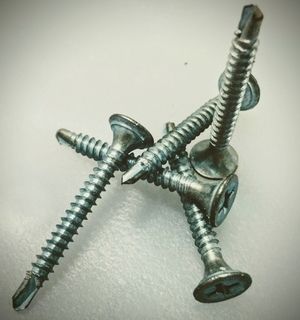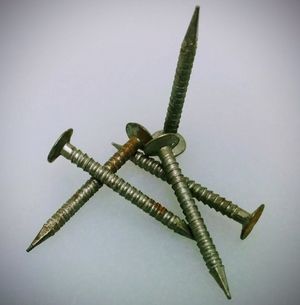
Options for securing drywall
Sheets of drywall can be secured using a variety of methods. Below we describe some best practices for fastening drywall. Residential homes are often built using wood stud framing while commercial buildings often use steel stud framing. The type of framing does not greatly affect the method of fastening but it may affect the type of fastener chosen. Nails cannot be used in steel stud construction framing applications.
Drywall screws
Drywall screws are the most common fastener used to install drywall. There are two main types of screws used for drywall, coarse thread and fine thread. Fine thread drywall screws are made specifically for use with steel studs. Fine thread screws can be used when installing drywall on wood studs, but coarse thread drywall screws cannot be used with steel stud framing. Coarse thread screws are better suited for wood stud framing. Coarse thread screws drive into the wood slightly faster than fine-thread and bite stronger in the wood below. Self-tapping fine-thread drywall screws are even better than regular fine-thread screws for steel stud framing, particularly when installing drywall over heavy gauge steel studs.
Picture of self-tapping fine thread drywall screws:
The second thing to consider when purchasing drywall screws is the length. Drywall screws come in a variety of lengths. The most commonly used lengths are 1-¼ and 1-⅝ inch long drywall screws. The shorter the screw, the easier it is to install. Long screws tend to lean over so you have to be extremely careful to keep them straight when pushing them in with the screw gun. Even the slightest pressure off-center will tip them over.
Drywall Nails
Though less common than drywall screws, nails are still a useful method for installing drywall. Drywall nails are unique to other nails in the construction of their cupped head and thin post, or shank. The head of drywall screws is large and flat with a slightly cupped top. The flat large head serves to hold pressure against the drywall paper while not perforating the surface. The thin, straight shank allows the nail to drive through the drywall and into the wood below while not cracking the drywall as it penetrates. Unlike wood framing nails that get holding power from both shank friction and head pressure, drywall nails holding power comes mainly from the pressure of the head against the paper. Friction from the shank against the gypsum does little to secure the board.
Picture of ribbed drywall nails:
Spacing
The International Residential Code (IRC) chapter 7 outlines minimum spacing requirements for fastening interior gypsum panels. The specific spacing required depends upon several factors including ceiling or wall application, the maximum spacing of framing members, whether drywall is hung at right angles to the studs or perpendicular to the studs, whether insulation is used in ceilings, and whether water-based textures are used.
In general, if you are using nails, they should be spaced no more than 7 inches apart and screws can generally be spaced 12 inches apart. In practical terms, this translates to about 8 nails or 5 screws on each stud when hanging 48-inch sheets perpendicular to the studs. If drywall adhesive is used, fasteners are needed generally only every 16, and in some cases, 24 inches.
As an alternative when using drywall nails, instead of spacing them every 7 inches, it is acceptable to install 2 nails 2" apart every 12 inches. In the long run, you end up using the same amount of nails but one advantage to this method is that double nailing every 12 inches makes for an easier finish job.
When determining fastener spacing whether using nails or screws, it is important to consult local building codes. All states in the U.S. except Wisconsin have adopted the IBC but even where the IBC is used, local building departments may have specific laws that apply to construction in their jurisdiction. Some require the drywall hanging be inspected by a local building inspector before taping and finishing can begin.
What length of nails or screws are best for installing drywall?
The length of the drywall screw or nail used depends on the thickness of the drywall you are installing. You need to use a fastener that is long enough to secure the drywall sheets properly but drywall screws that are too long are a pain to install. If you are using a drywall screw gun or even a cordless drill, long screws tend to slip from the drill bit and fall over before they drive into the drywall. You must make sure that the screw is inserted exactly perpendicular to the sheet to prevent this. As mentioned above, the most common length drywall screws used are 1-⅜ and 1-⅝ inch long drywall screws.
You should always refer to the manufacturer’s recommendations when it comes to determining the type of fastener to use. In general, the principles below will give you a basic idea of what type of screws or nails can be used. However, if the manufacturer's recommendations are different from what is presented here, you should always go with their recommendation.
Guidelines for determining drywall screw length
The International Residential Code (IRC) stipulates that drywall fasteners should be Type W or Type S and shall penetrate the wood not less than ⅝ inch. This means that in general, you need to use fasteners that are at least ¾ inch longer than the thickness of drywall being used. Chapter 7 of the IRC table R702.3.5 provides specifics about what size nails or screws should be used for different wood framing applications. The following are general guidelines for estimating purposes. For specifics, please refer to your local municipality building requirements.
Single layer drywall:
- ¼ inch drywall - 1-inch drywall screws are long enough
- ⅜ inch drywall - 1-¼ or 1-⅜ inch drywall screws are long enough
- ½ inch drywall - use 1-¼ or 1-⅜ inch long drywall screws
- ⅝ inch drywall - use 1-⅝ inch long screws
Double layer drywall:
- Double layer ½ inch drywall - Use 1-⅜ for the first layer and 1-⅝ for the second layer.
- Double layer ⅝ inch drywall - Use 1-⅝ for the first layer and two-inch long screws for the second layer.
Glue
Drywall adhesive is a very effective means of securing drywall panels. Glue is an excellent way to prevent screw-pops and cracking joints. When using drywall adhesive it is not necessary to use as many nails or screws. Generally, glue is applied to the studs and then a few fasteners are used on the edges and a few in the middle to hold the sheet in place until the glue dries. The main negative to using glue is the extra time involved needed to squirt adhesive on the studs and the added cost of glue. Drywall adhesive is available from a variety of different manufacturers. One type of glue of note is Green Glue noise-proofing adhesive. It helps to dampen noise transfer between walls and is best used in conjunction with a total sound dampening system


